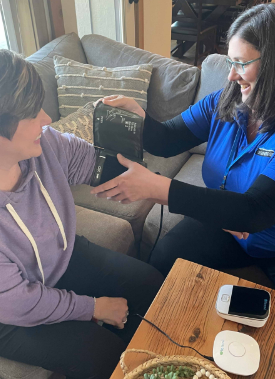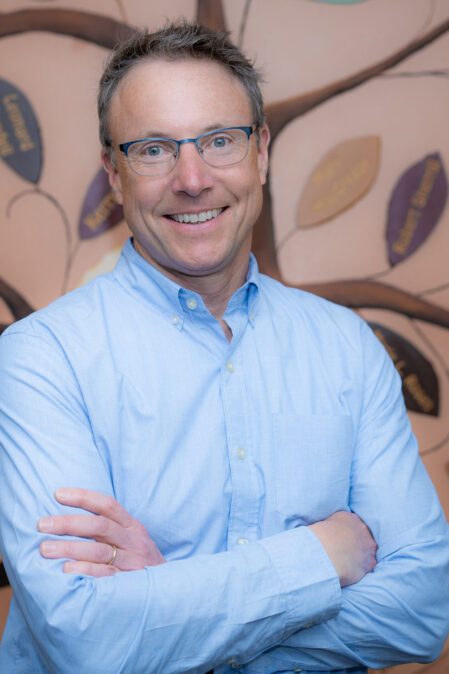
Rachel Huckaby is a community health worker for the Cascade Medical Center. A community health worker’s role is to connect with community members and help them access healthcare and other resources that can improve the quality of their lives.
This often involves visiting with elderly community members in their homes, usually to drop off a blood pressure cuff that is part of the hospital’s innovative remote patient monitoring program that helps doctors and nurses keep tabs on patients without seeing them in person.
“I visited a woman who appeared that she is unable to get out of her home,” Huckaby said. “Most times, people just want me to hook up their blood pressure cuff and show them how to use it. They don’t really chat. But this woman wanted me to sit down and talk. She told me about a friend that lived far away. I could tell she just craved someone to visit with and talk to. It was great.”
Huckaby plays a vital role in Cascade Medical Center’s goal of helping area seniors age in their homes. It’s a focus derived from data that the hospital collects through required community needs assessments and additional surveying.
The medical center’s service area, which includes Cascade and a part of Donnelly in rural Valley County, has an average age of 56. That’s significantly older than the Idaho average age of 36.
“We’re on average a whole generation older than Idaho as a whole,” Cascade Medical Center CEO Tom Reinhardt said. “We were looking for a way to help people age independently with health and joy at home, which is what they want to do.”
It is a challenging problem. Cascade’s long winters make driving to necessary services in McCall or Boise more daunting and potentially dangerous. There are no assisted living facilities in the area and just one nursing home in nearby McCall.
“You either have to be completely independent or completely dependent to live up here,” Reinhardt said. “If you’re in that middle ground – and that’s a big middle ground – then you’re really troubled and stuck. If they don’t have immediate family here, they’ve got to move, even though they would rather to continue to live independently at home, but they lose that ability to be independent.”
The medical center partnered with other agencies, including the City of Cascade, EMS and other groups, to chart a course that would help seniors age in their own homes.
THE NEXT STEPS
Transportation to medical appointments was a huge need, which got Reinhardt and others thinking about other ways residents could be supported without necessarily needing transit. As a result, remote patient monitoring and hiring a community health worker were among other priorities.

A grant from the Blue Cross of Idaho Foundation for Health to pilot a program that linked healthcare and community efforts allowed Cascade Medical Center to begin implementing some of these solutions. The Foundation’s mission is to address the root causes that impact health, and this pilot grant provided the opportunity to see how a community health worker can positively impact the aging population.
“The community health worker is out amongst the people to help identify needs,” Reinhardt said. “We have seen it work and improve peoples’ lives.”
Huckaby agrees. She’s lived in Cascade for 18 years and is a member of city council and has served on the library board and runs a community pottery studio. As connected as she is to her home, she didn’t fully realize how needed her community health worker role is in the community.
“I didn’t realize there’s so many people that really can’t get out of their homes,” Huckaby said. “I went with a pastor and his wife to deliver food boxes to people who are shut in, and we went to about 20 different homes. It just opened my eyes to that. It’s been really great to connect with those people. A lot of times I think my visits are more helpful mentally to people.”
Huckaby has helped more than 35 people take part in the remote patient monitoring program, which helps patients who may have congestive heart failure, COPD, diabetes, and other health conditions. Huckaby takes the device to the patient’s home and trains them how to use it.
“Remote patient monitoring is one of the proactive, out-of-the-box ways that we are providing care to the patients in our community,” said Shelby Hallan, the nurse manager for the emergency department at Cascade Medical Center.
The devices transmit blood pressure readings directly into the patients’ charts, which are monitored by emergency department nurses daily.
“If any hypertensive or hypotensive readings are documented, the RNs will contact the patient and the on-call provider with a plan for their blood pressure,” Hallan said.
TRANSPORTATION GRANT
Cascade Medical Center received a federal grant from the Health Resources and Services Administration that allowed it to purchase a ADA-compliant van that has been used by hundreds to get to non-emergency medical appointments. Drivers were hired and trained to transport patients.

Huckaby promotes the van service whenever she can, letting people know it’s a service they can use to get to their medical appointments.
For Caroline (last name omitted for privacy purposes), transport was vital because she lives 12 miles outside of the Cascade city limits. When asked how she would have gotten to her medical appointments, she responded, “I probably wouldn’t.”
Missed appointments can result in poor health outcomes and disrupt an already strained healthcare system that is short on doctors, nurses, specialists, and more.
“Transportation is a huge barrier to them not being able to live here in Cascade,” Reinhardt said. “We provide that non-emergency patient transportation service that is essential, especially during the winters.”
The transport will take patients to their appointments in Cascade, McCall and even Boise.
“There aren’t enough nice things I can say about it,” Caroline said. “It’s easy to use and I get to my appointments on time.”
Patient Adele (last name omitted for privacy purposes) was recovering from knee replacement surgery when she fell at ruptured her quadriceps tendon in late 2022.
“I was in a leg brace from ankle to groin, and the physical therapy was integral to my improving and getting better,” she said. “It was winter and there was no way I wanted to drive in the snow and ice. I’m very grateful I live in an area that had transportation service, and it’s nice to know it’s available for those who need it.”
Without the transit, Adele would have had to try to find in-home therapy that was hard to come by. That’s one reason the medical center added an in-home physical therapy program, in which physical therapists travel to patient’s home to provide care.
“Often people need physical therapy to get stronger to reduce their risk of falling,” Reinhardt said. “Because we know once they have a fall, that’s the beginning of their loss of independence. If they can’t get physical therapy because they have mobility issues or can’t drive, then we can go to their home. It’s been very popular.”
All of these solutions – community health worker, transit, remote patient monitoring and in-home physical therapy – are improving the quality of life for Cascade’s aging senior population. The medical center has found viable ways to connect healthcare to the community, which was the goal of the pilot grant it received from the Blue Cross of Idaho Foundation for Health.
